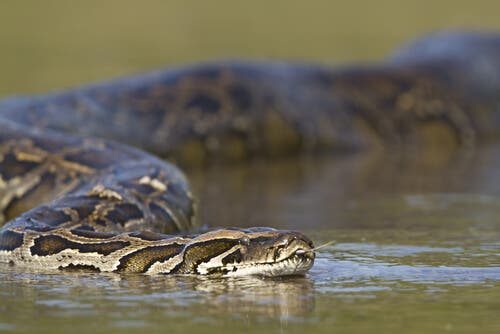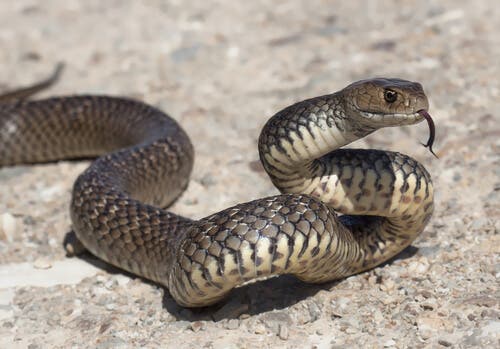Latin America’s Most Venomous Snakes


Written and verified by the lawyer Francisco María García
Many people have a real fear of cobras, but there are only a few species that are venomous. When faced with the most venomous snakes in the world, we need to know how to act.
The bite of some species can be lethal and require immediate treatment to prevent irreversible damage to the victim’s health.

Here we summarize the eight most poisonous snake species and tell you a little more about them:
The rattlesnake
The rattlesnake is virtually synonymous with poison in many countries. This ‘fame’ is not born by chance. These species of vipers originating in the American continent can be lethal.
They’re very easy to identify by the rattle at the end of their tail, which makes a very particular sound when moving.
Around 96% of rattlesnake bites are not fatal when the patient receives immediate treatment. But, without proper medical attention, poison often causes irreversible damage and can lead to death.
The Belcher marine snake
Although they’re not all venomous, the Belcher sea snake is among the most poisonous in the world. They’re easy to recognize thanks to their distinctive stripes – they have a large striped body. Like most, they’re not aggressive animals and only use their bite when they feel threatened.
Although one in four animals of this species is poisonous, its effects are fast and deadly. It’s estimated that just a few milligrams of its poison can cause the death of up to 1000 people. However, many Belcher marine snakes are harmless and docile.
Most venomous snakes in the world: Death adders
Its name already lets us know why these snakes are among the most venomous snakes in the world. Death Adders are native to Australia and New Guinea. They’re quite unattractive because of their dark color and the peculiar appearance of its skin.
They regained international fame thanks to the legend that Cleopatra had committed suicide with its poison; which is either a myth or an unrecognized historical fact. But what we do know is that the poison of a Death Adder can lead to respiratory arrest or death in less than six hours.
Once again, immediate treatment is crucial to save the victim’s life and avoid irreversible paralysis. Without immediate attention, more than 50% of death adder bites are lethal.
The Eastern brown snake
This species, originating in Australia, differ from the other most poisonous snakes on the planet because they’re aggressive. In fact, if they identify a prey or a threat they can pursue them even outside their territory. Therefore, it isn’t uncommon to spot them in Australian cities.

Only 50% of Eastern brown snakes are poisonous, but their attack can easily lead to paralysis or death. Thanks to their high aggressiveness and remarkable courage, these snakes are among the most dangerous animals in the world.
Malayan krait
Malayan kraits aren’t as well known as other species, but they’re equally poisonous. Their poison is up to 16 times more potent than a cobra’s.
Moreover, an efficient antidote to its bite is not yet known, making it one of the deadliest snakes in the world. Fortunately, Malayan kraits usually stay isolated from cities and only go out for food during the evenings.
Black Mamba
Black mambas are native to the African continent. They stand out not only for their powerful poison but also for their agility. A black mamba can travel faster than 12mph through their natural habitat.
Like the Eastern brown snake, the black mamba often bites several times in the same attack. Their victims need immediate treatment to inhibit the rapid and potent action of their poison.
Tiger snake
The tiger snake is originally from Australia and is often easily identifiable by the wide yellow bands of their bodies. They have a very powerful poison and its bite is almost always precise, which makes it a really dangerous animal.
Around 75% of the victims of tiger snake bites can die if they don’t receive immediate attention.
The Philippine cobra
Unlike the other more poisonous snakes, the Philippine Cobra can poison its prey without needing to bite. These species are capable of spitting their poison from a distance of almost 10 feet, which almost immediately paralyzes their victim. If a person comes into contact with the poison of a Philippine cobra, they will need treatment in less than 30 minutes.
Many people have a real fear of cobras, but there are only a few species that are venomous. When faced with the most venomous snakes in the world, we need to know how to act.
The bite of some species can be lethal and require immediate treatment to prevent irreversible damage to the victim’s health.

Here we summarize the eight most poisonous snake species and tell you a little more about them:
The rattlesnake
The rattlesnake is virtually synonymous with poison in many countries. This ‘fame’ is not born by chance. These species of vipers originating in the American continent can be lethal.
They’re very easy to identify by the rattle at the end of their tail, which makes a very particular sound when moving.
Around 96% of rattlesnake bites are not fatal when the patient receives immediate treatment. But, without proper medical attention, poison often causes irreversible damage and can lead to death.
The Belcher marine snake
Although they’re not all venomous, the Belcher sea snake is among the most poisonous in the world. They’re easy to recognize thanks to their distinctive stripes – they have a large striped body. Like most, they’re not aggressive animals and only use their bite when they feel threatened.
Although one in four animals of this species is poisonous, its effects are fast and deadly. It’s estimated that just a few milligrams of its poison can cause the death of up to 1000 people. However, many Belcher marine snakes are harmless and docile.
Most venomous snakes in the world: Death adders
Its name already lets us know why these snakes are among the most venomous snakes in the world. Death Adders are native to Australia and New Guinea. They’re quite unattractive because of their dark color and the peculiar appearance of its skin.
They regained international fame thanks to the legend that Cleopatra had committed suicide with its poison; which is either a myth or an unrecognized historical fact. But what we do know is that the poison of a Death Adder can lead to respiratory arrest or death in less than six hours.
Once again, immediate treatment is crucial to save the victim’s life and avoid irreversible paralysis. Without immediate attention, more than 50% of death adder bites are lethal.
The Eastern brown snake
This species, originating in Australia, differ from the other most poisonous snakes on the planet because they’re aggressive. In fact, if they identify a prey or a threat they can pursue them even outside their territory. Therefore, it isn’t uncommon to spot them in Australian cities.

Only 50% of Eastern brown snakes are poisonous, but their attack can easily lead to paralysis or death. Thanks to their high aggressiveness and remarkable courage, these snakes are among the most dangerous animals in the world.
Malayan krait
Malayan kraits aren’t as well known as other species, but they’re equally poisonous. Their poison is up to 16 times more potent than a cobra’s.
Moreover, an efficient antidote to its bite is not yet known, making it one of the deadliest snakes in the world. Fortunately, Malayan kraits usually stay isolated from cities and only go out for food during the evenings.
Black Mamba
Black mambas are native to the African continent. They stand out not only for their powerful poison but also for their agility. A black mamba can travel faster than 12mph through their natural habitat.
Like the Eastern brown snake, the black mamba often bites several times in the same attack. Their victims need immediate treatment to inhibit the rapid and potent action of their poison.
Tiger snake
The tiger snake is originally from Australia and is often easily identifiable by the wide yellow bands of their bodies. They have a very powerful poison and its bite is almost always precise, which makes it a really dangerous animal.
Around 75% of the victims of tiger snake bites can die if they don’t receive immediate attention.
The Philippine cobra
Unlike the other more poisonous snakes, the Philippine Cobra can poison its prey without needing to bite. These species are capable of spitting their poison from a distance of almost 10 feet, which almost immediately paralyzes their victim. If a person comes into contact with the poison of a Philippine cobra, they will need treatment in less than 30 minutes.
This text is provided for informational purposes only and does not replace consultation with a professional. If in doubt, consult your specialist.








